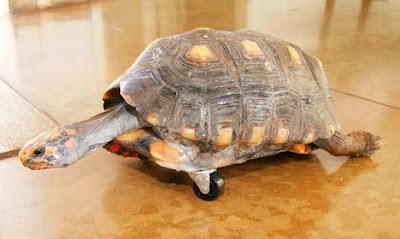
Tortoises are among the oldest species on the planet, remaining virtually unchanged for millions of years -- but sometimes they too need a replacement part every now and then. When a severely injured red-footed tortoise was discovered recently in Uberaba, Brazil, it seemed to be on the verge of death. A team of surgeon from the local veterinary hospital succeeded in saving the animal's life, but injuries forced to amputate one of its front legs. Just when it looked certain that the tortoise would never walk again, one of the vets had an ingenious idea -- to reinvent the wheel, tortoise style.
One of the surgeon responsible for saving the tortoise, wildlife expert Cláudio Yudi of the Veterinary Hospital of Uberaba, suspects that the animal injured its foot on an electric fence. By the time the tortoise was discovered, an infection had overtaken its leg to the point that the appendage could not be salvaged -- leaving the team with no choice but to amputate it.
Yudi told Brazilian media that he then devised a plan to help the tortoise walk again. Using a bit of plastic resin, he secured a common furniture caster to the underside of its shell where the leg had been, returning to the tortoise some semblance of its former locomotion.
Amazingly, the tortoise is said to be recovering well and has even learned to walk with its replacement wheel. Unfortunately, the limitations of the improvised prosthetic leg on rough terrain mean the animal cannot survive in the wild.
Red-footed tortoises are native to the forests of South America where they face a variety of threats from human interaction. They are a prime target for hunters looking to ship them throughout the continent to be made into pets or eaten as a food source. But perhaps more pressingly, the encroachment of development within their habitats means a higher likelihood the tortoises will be injured or killed by industrial equipment and infrastructure -- in this case, an electrified fences.
Their close genetic cousins, South American yellow-footed tortoises, have already been driven to near extinction from similar threats in their habitat, earning them the designation as an endangered species. It may be only a matter of time until red-footed tortoises are granted similar protections.
Granted, persistence and stubborn determination have long been counted among the tortoise's chief strengths, but sometimes they too need a helping hand along the way to ensure their preservation -- regardless of the form that hand may take.
One of the surgeon responsible for saving the tortoise, wildlife expert Cláudio Yudi of the Veterinary Hospital of Uberaba, suspects that the animal injured its foot on an electric fence. By the time the tortoise was discovered, an infection had overtaken its leg to the point that the appendage could not be salvaged -- leaving the team with no choice but to amputate it.
Yudi told Brazilian media that he then devised a plan to help the tortoise walk again. Using a bit of plastic resin, he secured a common furniture caster to the underside of its shell where the leg had been, returning to the tortoise some semblance of its former locomotion.
Amazingly, the tortoise is said to be recovering well and has even learned to walk with its replacement wheel. Unfortunately, the limitations of the improvised prosthetic leg on rough terrain mean the animal cannot survive in the wild.
Red-footed tortoises are native to the forests of South America where they face a variety of threats from human interaction. They are a prime target for hunters looking to ship them throughout the continent to be made into pets or eaten as a food source. But perhaps more pressingly, the encroachment of development within their habitats means a higher likelihood the tortoises will be injured or killed by industrial equipment and infrastructure -- in this case, an electrified fences.
Their close genetic cousins, South American yellow-footed tortoises, have already been driven to near extinction from similar threats in their habitat, earning them the designation as an endangered species. It may be only a matter of time until red-footed tortoises are granted similar protections.
Granted, persistence and stubborn determination have long been counted among the tortoise's chief strengths, but sometimes they too need a helping hand along the way to ensure their preservation -- regardless of the form that hand may take.
No comments:
Post a Comment